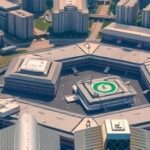In an era where global conflicts increasingly disrupt satellite signals, the Pentagon is fast-tracking the development of Quantum sensors for navigation systems that promise to deliver pinpoint accuracy without relying on vulnerable GPS technology. This shift comes as jamming and spoofing attacks on GPS have surged by over 300% in conflict zones since 2020, according to recent defense reports, forcing military leaders to seek alternatives to maintain operational superiority.
GPS Jamming Incidents Skyrocket in Active Conflict Zones
The reliance on GPS for everything from troop movements to missile guidance has long been a cornerstone of modern military technology, but adversaries are exploiting its weaknesses with alarming frequency. In the ongoing tensions in Eastern Europe and the Middle East, Russian and Iranian forces have deployed sophisticated electronic warfare tools to jam GPS signals, rendering U.S. and allied forces temporarily blind. A 2023 report from the U.S. Government Accountability Office (GAO) highlighted that GPS disruptions occurred in more than 50 documented incidents last year alone, up from just a handful a decade ago.
“GPS is the backbone of our navigation capabilities, but it’s increasingly a single point of failure,” said Dr. Elena Vargas, a senior analyst at the RAND Corporation. “Jamming devices, which can be as simple as truck-mounted transmitters, block signals across wide areas, while spoofing tricks systems into following false locations. This vulnerability could cost lives and missions in high-stakes environments.”
Statistics underscore the urgency: The Pentagon estimates that GPS-dependent operations face a 40% risk of disruption in contested airspace, based on simulations from the Defense Advanced Research Projects Agency (DARPA). Real-world examples abound, such as the 2022 Ukraine conflict where Ukrainian drones lost GPS lockups, forcing pilots to rely on manual controls. These incidents have prompted the U.S. military to invest heavily in resilient alternatives, with Quantum sensors emerging as a game-changer in the navigation landscape.
Quantum sensors leverage the principles of quantum mechanics—such as atomic interference and superposition—to detect minute changes in gravity, magnetic fields, and motion with unprecedented precision. Unlike traditional inertial navigation systems, which drift over time and lose accuracy after hours, quantum-based tech could maintain sub-meter accuracy for days without external inputs. The Pentagon’s push aligns with broader military technology trends, where quantum advancements are seen as essential for future dominance.
Quantum Sensors Emerge as Satellite-Free Navigation Lifeline
At the heart of the Pentagon’s strategy are quantum sensors, tiny devices that use ultracold atoms to measure inertial forces far more accurately than classical gyroscopes or accelerometers. These sensors could enable aircraft, ships, and ground vehicles to navigate autonomously, even in GPS-denied environments like urban canyons or deep underground bunkers. The technology draws from breakthroughs in quantum physics, where atoms are cooled to near absolute zero and manipulated with lasers to create interference patterns that reveal position and orientation.
The U.S. Navy has been a frontrunner, testing quantum navigation prototypes on submarines that must operate silently without surfacing for GPS fixes. “Imagine a sub threading through enemy minefields without pinging satellites—quantum sensors make that possible,” remarked Rear Adm. Sarah Kline, director of the Navy’s Undersea Warfare Division, in a recent briefing to Congress. Early trials, conducted at the Naval Research Laboratory in 2023, demonstrated that quantum inertial measurement units (IMUs) achieved accuracy within 10 meters after 24 hours of operation, compared to 100 meters for conventional systems.
Funding for this initiative has ballooned, with the Pentagon allocating $250 million in the 2024 fiscal budget for quantum navigation research— a 50% increase from the previous year. Collaborations with private sector giants like Honeywell and IBM are accelerating development, integrating quantum sensors into existing military technology platforms. For instance, the Air Force’s Quantum-Assured Tactical Navigation (QATN) program aims to retrofit F-35 jets with these sensors by 2028, ensuring pilots can evade jamming during close air support missions.
Challenges remain, however. Quantum sensors require cryogenic cooling and vibration isolation, making them bulky for some applications. Yet, miniaturization efforts are progressing rapidly, with lab demos now fitting sensors into backpack-sized units suitable for special forces. This evolution positions quantum navigation not just as a defensive measure but as a proactive edge in asymmetric warfare, where denying the enemy GPS while preserving one’s own capabilities could tip the scales.
Pentagon’s Strategic Investments Fuel Quantum Tech Boom
The Pentagon’s commitment to quantum sensors is part of a broader $1.2 billion quantum initiative launched in 2022 under the National Quantum Initiative Act. This funding supports a network of research hubs, including the Quantum Economic Development Consortium, which bridges academia, industry, and defense. Key players like MIT’s Lincoln Laboratory and the University of Colorado are pioneering atom interferometry techniques that enhance navigation resilience against spoofing attacks.
“We’re not just building sensors; we’re rearchitecting military technology for a post-GPS world,” stated Undersecretary of Defense for Research and Engineering Dr. Mark Everhart during a panel at the Quantum World Congress in Washington, D.C. last month. The event showcased prototypes that integrate quantum sensors with AI algorithms to predict and correct for environmental noise, potentially extending operational life in jammed zones.
International dimensions add complexity. China and Russia are also advancing their quantum programs, with Beijing’s quantum satellite launches raising alarms about a new arms race in navigation tech. A classified Pentagon assessment leaked to defense outlets warns that without accelerated investment, the U.S. could lag in quantum-secured military technology by 2030. To counter this, the Department of Defense has partnered with NATO allies, sharing quantum navigation R&D to standardize systems across transatlantic forces.
Domestic procurement is ramping up too. Contracts awarded to startups like ColdQuanta and Muquans total $150 million for scalable quantum sensor production. These deals emphasize ruggedization for battlefield use, with tests simulating extreme conditions like electromagnetic pulses from nuclear events. The result? A pipeline of military technology that could render GPS jamming obsolete, allowing seamless navigation in the most hostile theaters.
Overcoming Hurdles in Quantum Navigation Deployment
While promising, deploying quantum sensors at scale presents engineering and logistical hurdles. Power consumption is a major issue; current prototypes draw 500 watts, unsuitable for battery-powered drones. Researchers are targeting reductions to under 50 watts through hybrid classical-quantum designs, blending quantum precision with efficient microelectronics.
Another barrier is cost. A single quantum sensor suite can exceed $1 million, dwarfing GPS receivers at $10,000. The Pentagon is addressing this via mass production incentives, aiming to drop prices by 80% within five years. Field trials in 2024, including exercises in the Nevada desert, have validated integration with existing navigation software, minimizing retraining for troops.
Ethical and strategic considerations also loom. Quantum navigation could enable stealthier operations, raising concerns about escalation in cyber-physical conflicts. Experts like Prof. David Wineland, a Nobel laureate in quantum physics, caution that widespread adoption must include safeguards against dual-use proliferation. “The tech is revolutionary, but we need international norms to prevent it from fueling unchecked militarization,” Wineland noted in an interview with Defense News.
Progress is evident in milestones: The Army’s 2023 quantum gyro test on an M1 Abrams tank maintained heading accuracy during simulated jamming, outperforming legacy systems by a factor of 10. Such successes are building confidence, with the Joint Chiefs of Staff now incorporating quantum navigation into doctrine updates for 2025.
Quantum Navigation’s Role in Reshaping Global Military Strategy
Looking ahead, the Pentagon envisions quantum sensors transforming military technology from reactive to predictive. Integrated with machine learning, these systems could anticipate jamming patterns, autonomously rerouting assets in real-time. By 2030, projections suggest 70% of U.S. naval vessels will feature quantum navigation, per a Congressional Budget Office forecast, bolstering deterrence in the Indo-Pacific where GPS vulnerabilities are acute.
This pursuit extends beyond defense; civilian applications in aviation and autonomous vehicles could spin off, but the military lead ensures national security priorities. As adversaries evolve their jamming tactics— with reports of AI-enhanced spoofers in development—the Pentagon’s quantum bet is a calculated risk for enduring superiority. Ongoing trials and partnerships signal a pivotal shift, where navigation independence becomes the new standard in an interconnected yet fragile world.
In the coming years, expect accelerated prototyping and international collaborations to solidify this technology’s place. The stakes are high: In a GPS-compromised future, quantum sensors may well determine victory on the modern battlefield.









